Materials
Metal vs. Canvas Prints: Picking the Best Wall Art Material for Your Budget & Style
Are you dreaming of transforming your bare walls into a captivating art gallery? The battle rages on—metal prints vs. canvas! Both options reign supreme in the ever-evolving interior design landscape, but which one conquers your space?
Metal prints offer a sleek, durable option with vibrant colors, while canvas prints provide a timeless, textured look that works in any setting. The best choice depends on your style preferences and the atmosphere you want to create.
This guide will walk you through the essential aspects of metal and canvas prints, including their unique features, pros and cons, aesthetics, durability, ideal use cases, costs, hanging, framing options, and more!
Metal vs. Canvas Prints: Key Differences
The table below can help you quickly see the core differences between metal and canvas prints
| Feature | Metal Prints | Canvas Prints |
| Style & Appearance | Sleek, modern, and multiple finishes; ideal for contemporary settings | Classic, warm, textured; works well in traditional and rustic decor |
| Color Vibrancy | High contrast, vibrant colors; glossy or matte finishes available | Softer, warmer tones; subtle and painterly effect |
| Durability | Highly durable; resistant to moisture, UV light, and scratches | Vulnerable to moisture and fading; better suited for dry indoor spaces |
| Maintenance | Easy to clean; can withstand exposure to sunlight and humidity | Requires gentle care; avoid direct sunlight and moisture |
| Best Use Cases | High-contrast images; landscapes, commercial spaces, outdoor display | Portraits, fine art reproductions, large wall decor |
| Longevity | 100+ years with proper care | 50–75 years; more susceptible to wear over time |
| Environmental Impact | Often recyclable aluminum; higher energy in production | Less recyclable; lower environmental impact in production |
| Budget | Typically more expensive, especially for custom finishes | Generally more affordable, especially in large formats |
| Installation Options | Lightweight; often uses French cleats or standoff bolts for mounting | Usually arrives stretched; can be hung directly or framed |
| Room Compatibility | Great for bright, high-traffic areas or bathrooms, kitchen and outdoor | Best for bedrooms, living rooms, and low-humidity spaces |
Understing Canvas and Metal Prints
What Are Canvas Prints?
Canvas prints are popular for those seeking a classic and artistic look for their wall art. Created by printing images onto high-quality cotton or polyester canvas, these prints offer a textured, painterly effect.
Most canvas prints are produced using giclée printing technology, which sprays tiny droplets of ink onto the canvas, resulting in rich colors and fine detail. Canvas prints come in a few varieties:
- Gallery-Wrapped Canvas: The canvas is stretched over a wooden frame, allowing the print to wrap around the edges.
- Floating Frames: Adds a subtle frame around the canvas, giving it a “floating” effect.
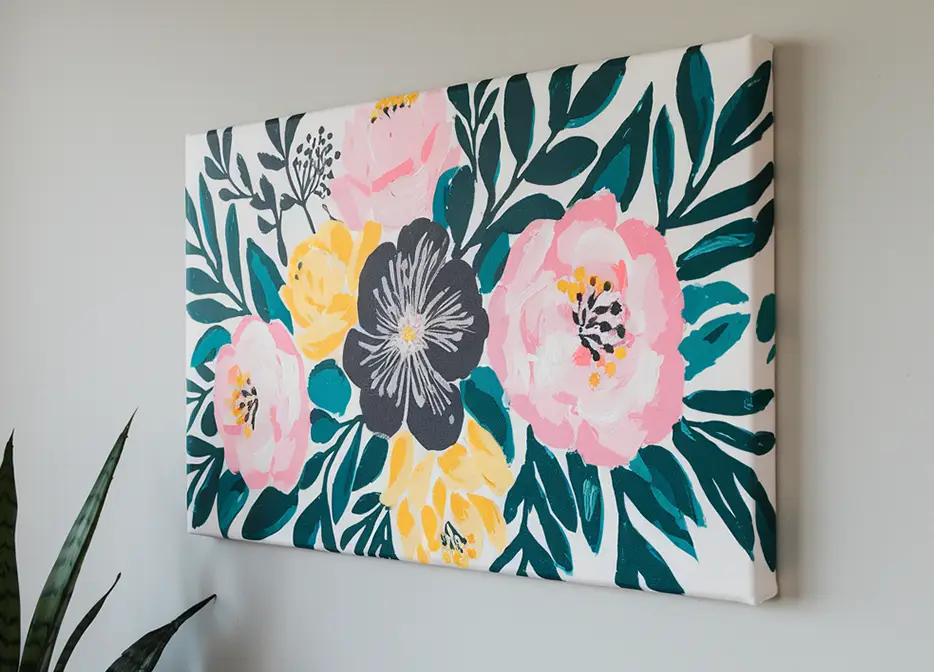
Pros and Cons of Canvas Prints
Pros:
- Classic Aesthetic: The canvas’s textured surface softens the image, providing a warm, timeless feel suitable for traditional or rustic decor.
- Affordable: Generally, canvas prints are more budget-friendly, especially for larger sizes.
- Lightweight and Easy to Hang: Canvas prints are lighter than metal prints, making them easier to hang and less demanding on wall supports.
- Versatile Framing Options: Canvases look great either unframed or framed, allowing flexibility in style and presentation.
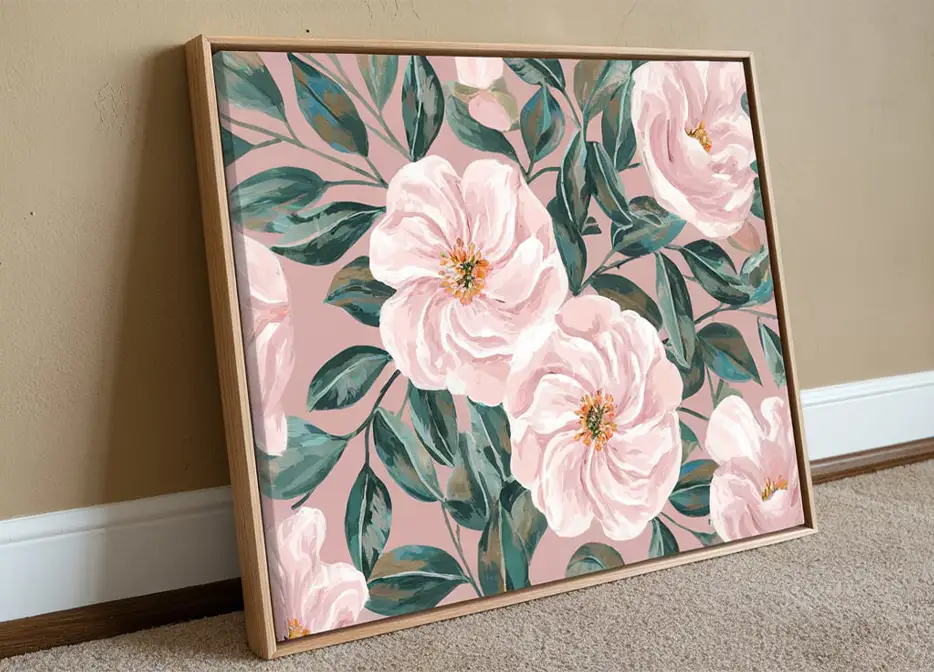
Cons:
- Vulnerability to Moisture: Canvas prints are not moisture-resistant and may warp or mold in humid environments.
- Dust and Maintenance: The textured canvas surface can attract dust, which requires gentle cleaning over time.
- Fading: Without UV protection, canvas prints may fade over time, especially in direct sunlight.
- Limited Color Intensity: Canvas prints have a softer, muted color profile than metal prints, which might not suit high-contrast images.
Canvas prints are ideal for creating a cozy, traditional ambiance in any space, particularly in homes and classic-themed interiors.
Because they balance affordability with style, offering a versatile option for various room styles, most artists use them for fine art reproductions, portrait photography, and large wall spaces where a warm, inviting look is desired.
An Overview of Metal Prints
Metal prints are known for their modern look and vibrant colors. They’re created by infusing dyes into specially coated aluminum sheets through HD dye sublimation. This technique allows for remarkable color depth, durability, and scratch resistance. There are several types of metal prints, including:
Types
There are several types of metal prints, including:
- Brushed Metal: The image is printed directly on the metal, allowing the metal to show through in lighter areas. This gives the image a unique, textured finish.
- White Base: The image is printed on a white coating first. It offers a true-to-color look with a solid white background.
Finishes
| Finish Type | Reflectivity | Color Vibrancy | Best Uses | Special Considerations |
|---|---|---|---|---|
| High Gloss | Very High | Maximum vibrancy | • Photography• Bold graphics• Modern art | • Shows fingerprints• Potential glare issues• High impact presentation |
| Semi-Gloss/Satin | Moderate | High | • All-purpose• Mixed media• Photography | • Good balance of vibrancy and practicality• Versatile lighting conditions |
| Brushed Metal | Low-Moderate | Moderate | • Architectural prints• Abstract art• Industrial designs | • Metal grain visible through image• Unique textural effect• Contemporary look |
| Matte | None | Moderate | • Fine art reproductions• Subtle images• Gallery displays | • No glare• Most subdued appearance• Professional look |
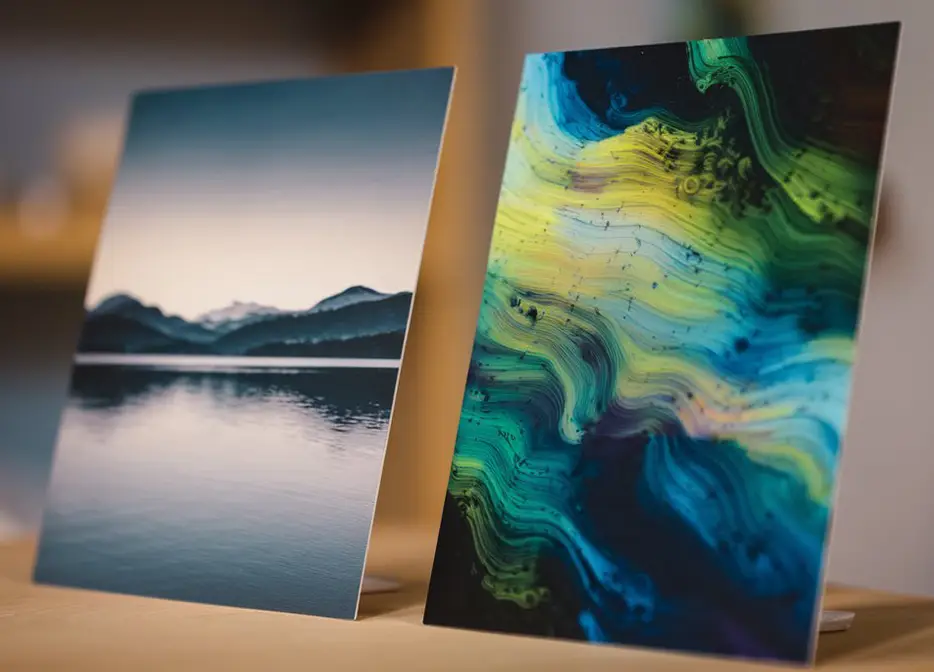
Pros and Cons of Metal Prints
Pros:
- Color Vibrancy and Detail: HD dye-sublimation offers unmatched vibrancy, making colors pop and details crisp.
- Durability: Metal prints resist scratches, water, and UV light, making them suitable for outdoor or high-traffic areas.
- Easy Maintenance: A simple wipe with a damp cloth keeps them looking fresh and bright.
- Lightweight: Aluminum is relatively light, making large metal prints easier to hang on most walls.
- Versatile Display: Metal prints often come ready to hang with unique mounting options like standoff bolts or French cleats, creating a floating effect.
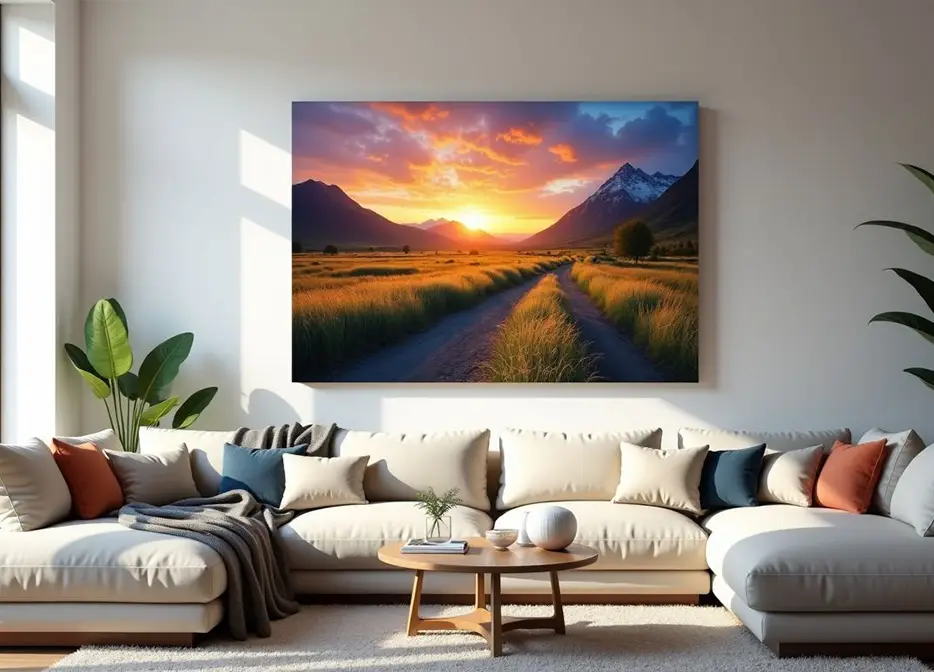
Cons:
- Higher Cost: Metal prints can be more expensive due to the materials and printing process.
- Glare: While beautiful, glossy finishes can produce glare in bright light; matte finishes can help reduce this.
- Limited Style Flexibility: Metal prints are best suited to modern or contemporary decor, as their sleek look may not fit classic or rustic spaces.
- Risk of Denting: Although tough, metal prints can dent if dropped or handled roughly, unlike canvas, which is more forgiving.
Metal prints excel in modern design settings, commercial spaces, and genres like landscape or architectural photography. Thanks to their durability, they’re also suitable for outdoor display under covered areas.
Choosing Between Metal and Canvas
When deciding between metal and canvas prints, consider a few key factors: style, budget, location, and image type.
- Style and Decor Compatibility: Metal prints, with their sleek, polished look and reflective surface, fit well in modern, minimalist, or industrial settings. With their softer texture and warm tones, canvas prints suit traditional or rustic spaces and add an artistic, gallery-like feel to a room.
- Budget Considerations: Metal prints generally cost more, especially in larger sizes or with custom finishes. Canvas prints are more affordable, especially for large formats, making them ideal for budget-conscious decorators or for filling expansive wall spaces without breaking the bank.
- Placement and Environment: Metal prints are a better choice for areas exposed to moisture, sunlight, or frequent handling due to their durability and easy maintenance. This makes them suitable for bathrooms, kitchens, or outdoor spaces. Canvas prints, while beautiful, are best kept indoors in dry, low-humidity areas to prevent potential warping or fading.
- Image Type: Metal prints enhance high-contrast, vibrant images like landscapes or architectural photography, bringing out bold colors and sharp details. Canvas prints are ideal for portraits or fine art reproductions where softer colors and a textured, classic look are desirable.
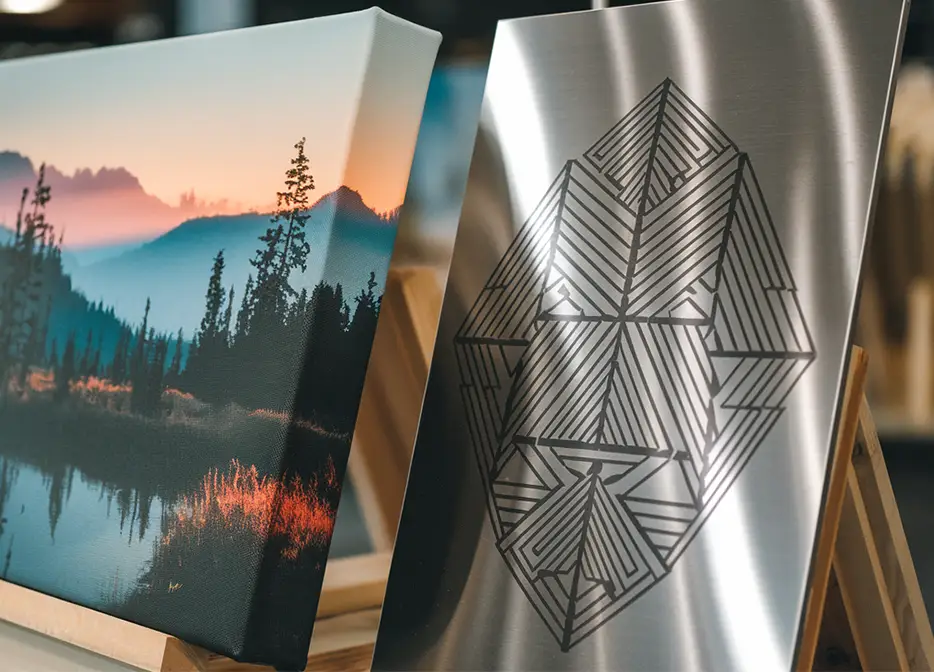
Ultimately, the choice between metal and canvas prints depends on your style preferences, display environment, and budget. Both offer unique advantages that make them worthy additions to any wall.
Whether you opt for the sleek, vibrant appeal of metal or the warm, textured beauty of canvas, you’ll enjoy a stunning print that enhances your space for years.
Alternatives to Canvas and Metal
While metal and canvas prints are popular choices, there are several other materials to consider for your wall decor:
Wood Prints
Wood prints offer a warm, rustic appeal. They can be printed directly onto wood surfaces or transferred onto wooden panels, adding a natural and organic touch to your space.
Acrylic Prints
These modern, glossy prints are sandwiched between two sheets of acrylic glass, creating a sleek, frameless look. Acrylic prints are durable and easy to maintain, making them an excellent option for contemporary spaces.
Further Reading:
Glass Prints
Images are printed directly onto tempered glass, resulting in a contemporary, minimalist aesthetic. Glass prints are highly durable and can create a striking visual impact.
Stone
For a truly unique and luxurious touch, consider stone prints. These prints are created by transferring images onto natural stone surfaces, such as slate or marble, resulting in a one-of-a-kind piece of art.
Paper
Traditional paper prints, such as fine art prints or giclée prints, offer a classic and timeless appeal. They can be framed or mounted for display, providing a versatile and affordable wall decor option.
References
- https://sewport.com/fabrics-directory/canvas-fabric
- https://canvasprints.com/blogs/news/types-of-canvas-prints
- https://www.artlex.com/printing/what-are-metal-prints/

